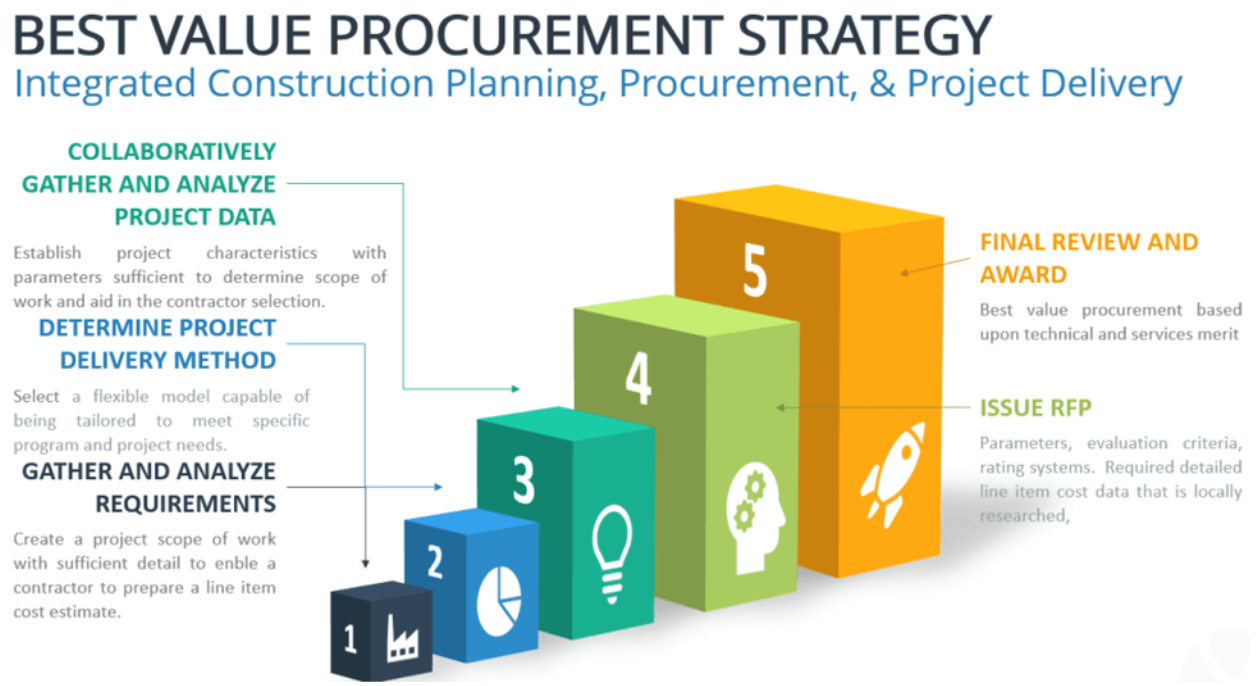Best Value Procurement: Cost is Not Always King
Written by Dane Dickerson

The best value procurement method (or best value contracting method) is a contemporary approach to construction procurement that places high emphasis on factors beyond just cost. It’s a procurement process that has been popularized in the private construction sector and is characterized by awarding projects to bidders based on how well they can do a job, rather than awarding the lowest project cost.
Traditional construction procurement methods that prioritize only lowering project costs, like the lowest responsible bidder method, can leave projects in limbo and lead to shady craftsmanship, change orders, or even litigation. While there are some cases where a cost-first approach is optimal, procurement is not a one-size-fits-all process.
Best value procurement has obvious performance strengths but is in some cases overkill. This article will help you decide when and how best value procurement can ensure you meet project deadlines under budget while exceeding quality requirements.
What Criteria Are Used To Judge Bidders In Best Value?
Best Value considers an extensive number of factors to determine a bidder’s competency. These factors are key in predicting what professional relationship bidding contractors may offer and an idea of their work quality. This process works best when a project team plans what criteria they will look for in advance and detail. Here are some examples of common criteria used in best-value procurement.
Cost
Project cost plays a slightly different role in best value procurement than other strategies. It is an important factor but is flexible in its importance. In a project plan with specific and rigid estimate parameters, it will be vital. Conversely, a project plan with more elasticity in its cost estimates and schedule will allow for another criterion to assume priority. This flexibility allows for creative approaches to procurement where traditional methods do not.
Performance
A bidder’s performance history is studied closely before a project is awarded. The performance of a contractor depends on to what extent they can finish a project on schedule, within budget, without injury, and with maximum quality. Much like positive references are vital to a job application, a positive performance history gives general contractors an idea of what work quality they can expect.
Quality Control
Adhering to a standard of quality is critical for contractors to secure a project award. This criterion is subjective and will look different depending on the type of project and its niche. Contractors able to instill a culture of quality-conscious workmanship in their project team will win favor in construction procurement.
Health and Safety
A history of on-site related injuries indicates a repeated inattention to safety guidelines. Health and safety in construction is defined by a contractor’s ability to communicate and label safety hazards, and routinely check worksite conditions to minimize risk. This criterion is crucial because it may save your project from unexpected delays, an increase in cost, and a negative work culture.
Project Control
An estimated project timeline and detailed cost projection are essential prerequisites to accurately measuring project control. Project monitoring and control is defined by a contractor’s ability to complete project steps on a specified timeline within a projected budget. Industry tools like Estimated Value Management (EVM) and performance forecasting are useful in measuring this criterion. Judging a contractor’s diligence in project control can give project owners an idea of how competently contractors can perform.
Delay Claims
The potential for delay claims can cause a negative relationship between client and contractor because they are often ambiguous and difficult to categorize. To mitigate miscommunication in delayed claims, best value procurement allows for a longer bid interview process. Clear discussion about risk factors, quality concerns, scope clarity, and timeline specifications is encouraged to decrease conflict between contractors, project teams, and owners. Being blinded by project cost in traditional procurement can prematurely skip this crucial step in ensuring mutual satisfaction.
Current Workload
The more projects and resources allocated for other projects simultaneously, the fewer resources available for a new project. Understanding a contractor and project team’s available resources is useful for estimating their ability to meet an owner’s expectations. Considering this in the procurement process can save a project from being neglected, missing deadlines, and estimating a project team’s bandwidth for open communication. While a contractor and team may have an excellent track record, they may currently be overextending themselves when a client needs their full attention.
What Does Best Value Look Like in Practice?
Best value often looks something like this:
- Project owners put out an invitation for bidders with a detailed project plan.
- Contractors and project teams submit their qualifications and proposals explaining why they are the ideal candidate for the project.
- Qualified project teams get placed on a short list of contenders for comparison.
- The project owner will interview each client and score them with a points-based system dependent on the criteria listed above and more.
- Bidding teams with the highest overall scores are awarded the project.

This method is effective for project owners looking to minimize risk in agreements. While the lowest responsible bidder procurement focuses on finding the lowest cost for a project, best value takes a much closer look at bidders before awarding for a more complete picture of their capabilities. The idea is to hire a team ready to do the job correctly the first time, rather than to hire cheaply and account for an increase in project cost down the line due to under-preparedness.
What Lowest Responsible Bidder Really Means
Picture this: You own a restaurant and need new servers. You’re looking for an employee that is friendly to customers, reliable, and a joy to work with. Would you A) hire the prospect offering to do the job for the lowest price, or B) hire the prospect with the most customer service experience and pleasant demeanor who is requesting a higher starting pay?
Answer A represents the lowest responsible bidder method, how procurement has been done for decades in construction and other industries. It has many industry pseudonyms like hard bid lump sum, and low bid, but the concept is essentially the same: Hire the bidder willing to do whatever is necessary to lower project cost and largely ignore other factors. When risks occur, the lowest responsible bidder method’s competitive advantage plummets.
Legal statutes and state regulations require that public construction projects must be bid on and awarded to the lowest bidder. This bidder is considered “responsible” because they should appear to possess the skillset and infrastructure to complete the project correctly. If you consider the example above in the context of the term, lowest responsible bidder, it doesn’t quite live up to its namesake.
This is because legal statutes regarding the lowest responsible bidder in public construction don’t give much information on how to determine their competency. Instead, projects are often just awarded to the bid with the lowest project cost. This is the case for many bidders, even if a closer look at their work history would suggest otherwise.
Drawbacks to Prioritizing Cost Over Value
While focusing on spending the least money possible sounds intuitive, it can be cause for headaches for general contractors in the long term. In many scenarios, the lowest responsible bidder method can lead to hidden costs and unexpected issues.
This method is high-risk because it ignores a bidder's work and safety history, quality of their materials, and litigation history. This could allow a contractor with a history of unsafe working practices to oversee your entire project. You get what you pay for, and an on-site injury, sketchy craftsmanship, or a litigation dispute could put you way over budget in the end.
Possibly the biggest failure of this procurement process is that it sets a project team up for an adversarial relationship. If your detailed project plan has minimum requirements, bidders in a cost-based procurement model will look at those as maximum requirements. Since the award goes to the lowest cost estimate, even vendors capable of producing high-quality work are incentivized to find ways to lower their costs.
Lowering costs to win awards can mean using lower-quality materials, increasing risk, and rushing work to reduce labor costs. This model also incentivizes vendors to plan on issuing change orders after receiving the award.
There are times when using a traditional cost-based low procurement method is favorable. Simply determining the cheapest bid option can be done on the day of bid opening, which would allow your entire project to get started faster. With smaller projects that require a lower skill ceiling and have less variability in work quality, awarding for the lowest cost may be less risky. If your project is expected to have a short duration and you want to build immediately, the lowest responsible bidder method is ideal.
Best Value Procurement Drawbacks
Best value procurement’s weakness is a slower speed to market. In the best value process, project owners are not just sorting for price. They are taking time to sort through more nuanced information about a bidder’s history for a more detailed idea of qualifications. This entails interviews, proposals, and a judging and scoring system.
The best value method’s more complicated approach means training to implement it is more complicated. Owners and clients may need to take courses to practice best-value procurement successfully, and there is much more room for error before one develops expertise in the process.
A final con is that best value does not prioritize saving money. While cost is a factor, you are unlikely to award the cheapest option using this method.
Parting Thoughts
Best value is a valuable procurement process for construction project execution. It can fall behind in overall cost and speed to market but will usually create higher customer satisfaction and performance and minimize risk.
Traditional cost-first procurement methods like the lowest responsible bidder are outdated. They focus too much on cost and are blind to important bidder criteria. They can still be useful for smaller projects and tight deadlines. However, if your company has been using traditional methods and is hoping for a higher-quality experience for all involved, it might be time to try something new.